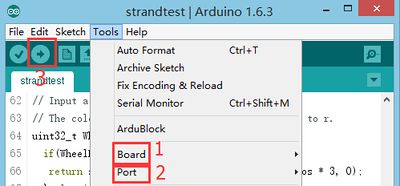Difference between revisions of "Time-lapse Photography"
From Microduino Wiki
| (8 intermediate revisions by 3 users not shown) | |||
| Line 19: | Line 19: | ||
===Preparation=== | ===Preparation=== | ||
| − | *Setup | + | *Setup 1: Connect the interface of the IR-Emitter to the D6 port of the Hub. (Note: The pin connection cannot be changed.) |
[[file:mCookie-IR transmitter-sensor.JPG|600px|center]] | [[file:mCookie-IR transmitter-sensor.JPG|600px|center]] | ||
| − | *Setup | + | *Setup 2: Stack the CoreUSB, Hub and IR-Emitter together and them connect them to a computer with a USB cable. |
[[file:mCookie-IR transmitter-pc.JPG|600px|center]] | [[file:mCookie-IR transmitter-pc.JPG|600px|center]] | ||
| Line 58: | Line 58: | ||
===Program Debugging=== | ===Program Debugging=== | ||
*Adopt " IRremote " infrared library to support the sending and receiving of the infrared signals. | *Adopt " IRremote " infrared library to support the sending and receiving of the infrared signals. | ||
| − | * | + | *"#define PHOTO 0xB4B8F" Define this SONY camera's infrared signal value. |
*Change the delay time; "delay(5000)" means five seconds. | *Change the delay time; "delay(5000)" means five seconds. | ||
==Experiment Two: Key Control Picture-taking == | ==Experiment Two: Key Control Picture-taking == | ||
| Line 78: | Line 78: | ||
===Hardware Buildup=== | ===Hardware Buildup=== | ||
| − | *Setup | + | *Setup 1: Connect the IR-Emitter to the Hub D6 and the Crash sensor to the Hub D8. |
[[file:mCookie-IR transmitter-pc.JPG|600px|center]] | [[file:mCookie-IR transmitter-pc.JPG|600px|center]] | ||
| − | *Setup | + | *Setup 2: Stack the CoreUSB, Hub, Crash and IR-Emitter together and them connect them to a computer with a USB cable. |
[[file:mCookie-IR transmitter-crash-pc.JPG|600px|center]] | [[file:mCookie-IR transmitter-crash-pc.JPG|600px|center]] | ||
| Line 141: | Line 141: | ||
} | } | ||
</source> | </source> | ||
| − | * | + | *"!=" means "Not equal to", which only performs when the pressed value changes. |
==Video== | ==Video== | ||
| − | + | ||
|} | |} | ||
Latest revision as of 23:37, 8 March 2017
| Language: | English • 中文 |
|---|
ContentsObjectiveHere we use the Microduino-IR Emitter to send infrared signal in the delayed time so as to control a SONY camera for picture taking and achieve time-lapse photography. Experiment One: System sends signal in the delayed timeEquipment
Preparation
Debugging
#include <IRremote.h>
#define PHOTO 0xB4B8F
IRsend irsend;
void setup() {
Serial.begin(115200);
pinMode(6, OUTPUT);
}
void loop() {
for (int i = 0; i < 3; i++)
{
irsend.sendSony(PHOTO, 20); // Sony code
delay(12);
}
delay(5000);
}
Program Debugging
Experiment Two: Key Control Picture-takingEquipment
File:IR Crash.jpg 600px Hardware Buildup
Software Debugging
#include <IRremote.h>
#define PHOTO 0xB4B8F
IRsend irsend;
#define pushButton 8
int buttonState, num;
void setup() {
Serial.begin(115200);
pinMode(6, OUTPUT);
pinMode(pushButton, INPUT);
}
void loop() {
buttonState = digitalRead(pushButton);
if (num != buttonState)
{
num = buttonState;
if (num == 0)
{
take();
Serial.println("take");
}
}
}
void take()
{
for (int i = 0; i < 3; i++)
{
irsend.sendSony(PHOTO, 20); // Sony code
delay(12);
}
}
You can target the IR Emitter to the camera's infrared receiver, then set the camera to remote control mode, press the key and button and the camera takes picture once. Program Description
buttonState = digitalRead(pushButton);
if (num != buttonState)
{
num = buttonState;
if (num == 0)
{
take();
Serial.println("take");
}
}
Video |
